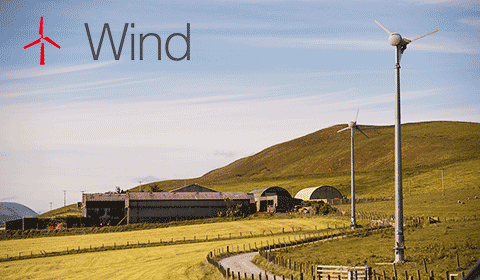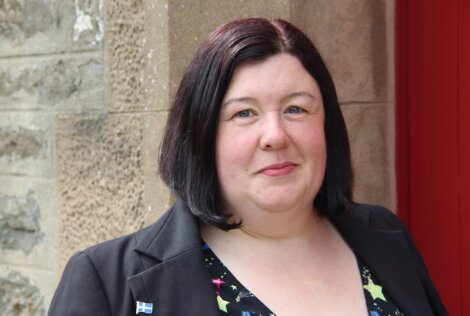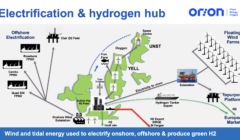Energy / A ‘fair share’? Differing views on Scatsta community benefit agreement
A “CAPITULATION to corporate power” or a much-needed multi-million pound boost to Shetland?
There are differing views to Shetland Islands Council’s (SIC) lease agreement with energy developer Statkraft for land near to the former Scatsta Airport for a hydrogen development, which was publicly confirmed on Wednesday.
The SIC stands to receive £1.13 million in rent a year as well community benefit money which at today’s value is worth around £2 million annually once things are up and running, possibly by 2032.
The SIC said these funds would be managed by the council and used to lever in further funding for strategic projects.
The Norwegian state-owned company proposes to build an electrolytic hydrogen to green ammonia production facility of up to 400MW on land adjacent to the disused Scatsta Airport.
This could use also excess renewable power, such as from wind farms, that cannot be utilised by the grid.
The agreement, believed to be the first community benefit deal for a non-wind farm project, has been criticised by Green councillor Alex Armitage, who said the SIC has “sold out to a huge corporation for a pittance”.
“To say I’m disappointed is an understatement,” he said, “I have never felt such visceral anger at an SIC decision.”
However, SIC leader Emma Macdonald said the project “aligns closely with the principles we recently approved in A Fair Share for Shetland, which aims to ensure our islands and our community benefit as much as possible from the development of renewable energy projects in our area”.
“There are a number of renewable projects either underway or in planning for Shetland, and it is critically important that we as a council do what we can to ensure the isles see a benefit if the projects proceed,” she added.
The agreement, however, does not exactly mirror community benefit principles endorsed by councillors in February.
Become a member of Shetland News
These principles, to be incorporated into negotiations with developers, promoted the idea of a 2.5 per cent share of gross revenue from hydrogen developments as well as a guaranteed minimum payment.
The Scatsta deal only features a fixed community benefit payment to the council of £5,000 per megawatt of installed capacity – the equivalent of around £2 million per annum at today’s value.
This is the same as the community benefit payout per megawatt from SSE’s 443MW Viking wind farm in Shetland’s Central Mainland.
There is a suggestion the parts of the agreement is at odds with some of the recommendations in the Fair Share for Shetland report referenced by Macdonald.
A chance to shape discussions about community wealth building
This report was published in November last year and produced by Shetland’s first Energy Transition Task Force, which was chaired by well-known specialist in community wealth building Neil McInroy.
It highlighted how the industry-standard of £5,000 per megawatt of community benefit was introduced in 2010, and that there are “strong and valid arguments” to suggest that projects starting in 2024 should begin paying around £7,300 per megawatt if payments were index-linked to 2010.
It also said that “community benefits in Shetland should be linked to production levels and value” rather than installed capacity, because of the isles’ strong natural resources, like wind.
When asked about this, Macdonald was keen to stress that there is no legal obligation to provide community benefit from energy developments.
“As a council, we have developed a set of guiding principles that we use when engaging with developers – our energy development principles that we approved in 2022 and our community benefit principles, which we approved back in February of this year,” the Shetland North councillor said.
“Community benefit is a voluntary arrangement that we have no way to mandate.
“This particular arrangement is different as it the first time that community benefit is being able to be used strategically by a local authority.”
She added that SIC officers will “always negotiate within the council adopted policy, but as I said, it is a voluntary arrangement”.
Macdonald also confirmed that the SIC will not receive any community benefit until the plant is operational – which at the moment is estimated to be 2032.
“Once we do have an income stream elected members will then decide how it will be spent most effectively,” she added.
But an angered Armitage believes the agreement is a missed opportunity, saying the land was the SIC’s “most strategic energy asset”.
“It has everything – brownfield site status, world-class port facilities, a grid connection and a location right in the middle of the best renewable energy resource in Europe,” he said.
“Scatsta had the potential to deliver tens of millions of pounds a year – economic security for Shetland and a sustainable future for schools, care homes and infrastructure.
“Instead, we have sold out to a huge corporation, for a pittance.
“Instead of learning from the mistakes of the Viking wind farm, it seems as though we are repeating them.”
Armitage said the report which went to councillors on community benefit in February was an “excellent” one which “laid strong strategic foundations for community ownership of renewables, as well as clear guidance for negotiations with developers”.
“The report put Shetland in a position of leadership, giving direction to other communities across rural Scotland for taking control of the energy transition,” he added.
“For green hydrogen projects, the report recommended that we claim 2.5 per cent of revenue.
“It felt like we were setting a standard – a fair share for Shetland. Instead, we settled for a paltry community benefit deal of £5,000 per installed megawatt.
“Though wind turbines and hydrogen production differ, £5k/MW is exactly the same as the Viking community benefit deal.
“It feels as though we have ignored the advice we were given, and misrepresented the Fair Share for Shetland principles.”
The Shetland South councillor also believed that there was a lack of political leadership at play during the process.
“For all the problems with party politics, I think the lack of political groupings in the council chamber has a lot to answer for, and there is a distinct lack of political leadership,” he said.
“Regardless of political party, groups of councillors are always more powerful than the sum of individuals.
“I don’t deny that there are some benefits with being represented by independents, but this is an example of where that system has hurt our community.
“In the future, historians will characterise our energy transition as a contest between Shetlanders and corporations.
“We have now lost yet another battle, but the quest for control of our land and sea is not over; many more projects are being planned.
“We can’t keep staggering on with the status quo. What we need now is real change to shift the balance of power in Shetland’s favour.”
The development, if it goes ahead, would be another large scale development in the North Mainland, sitting alongside Sullom Voe Terminal and the Shetland Gas Plant.
There are also plans for a power hub in the area too, where a second subsea HVDC power cable may come ashore, as well as the proposed ten-turbine Neshion Energy Park, which would also have battery storage.
Local councillor Andrew Hall said he felt Statkraft’s Scatsta development should have a positive impact on the local economy, “but at this stage there appears to be too many unknowns regarding hydrogen production to quantify what that will be”.
Stuart Marley, Statkraft’s principal hydrogen project manager, said the news of the lease arrangement marked an “exciting milestone for the potential to develop green hydrogen and ammonia production in Shetland”.
“This scheme offers an opportunity to combine Shetland’s renewable resources with innovative technology,” he added.
“The historic links with energy production mean there is a wealth of talent in the region to draw on to ensure projects are run safely and efficiently.
“While we are currently in the early stages of development, we will work closely with local stakeholders and the wider Shetland community, as we progress this project.”
Statkraft recently announced that it would stop development of new green hydrogen projects, but parts of its global portfolio, including “mature” projects such as Scatsta, will be developed further before the company seeks investors to take them forward.
Become a member of Shetland News
Shetland News is asking its readers to consider paying for membership to get additional perks:
- Removal of third-party ads;
- Bookmark posts to read later;
- Exclusive curated weekly newsletter;
- Hide membership messages;
- Comments open for discussion.
If you appreciate what we do and feel strongly about impartial local journalism, then please become a member of Shetland News by either making a single payment, or setting up a monthly, quarterly or yearly subscription.















































































